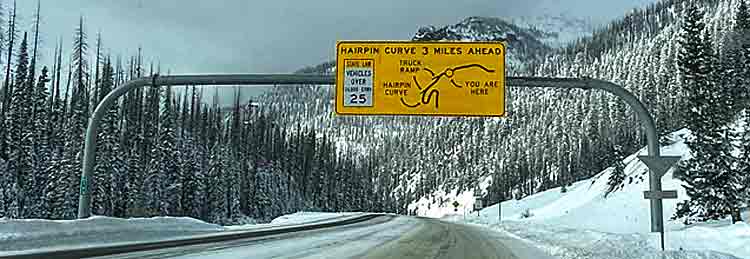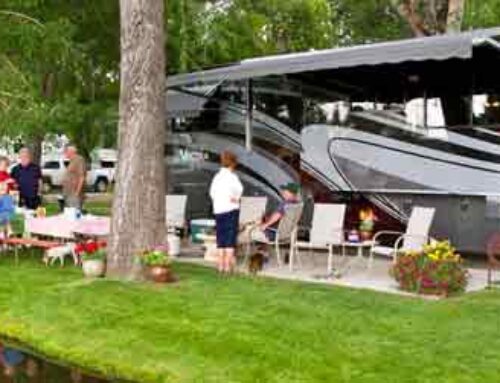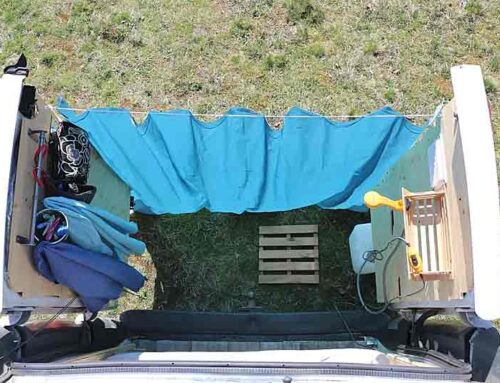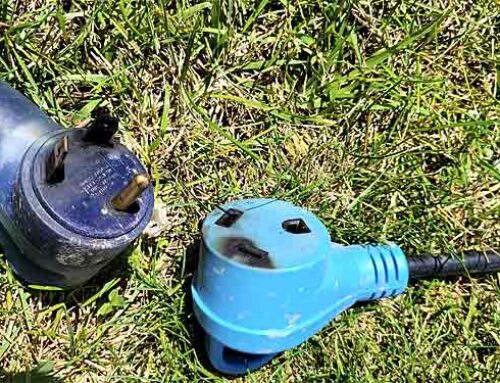How To Drive An RV In The Rocky Mountains
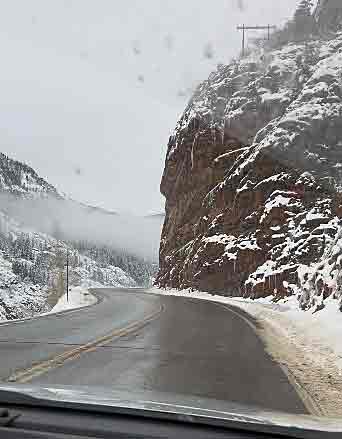
Having lived in Colorado for decades, my vintage motorhome and I have made countless treks over the Continental Divide and numerous other high country passes.
RV owners frequently post questions and concerns on Facebook and Instagram about safely navigating the ups and downs of mountain driving. Knowing the basics of power, braking, towing, and safety can make the difference between a great trip and an unfortunate experience.
Even though some of my photos show winter conditions, I DO NOT recommend driving a motorhome in the mountains when there is even a dusting of snow. These rear-wheel drive vehicles are just not good on ice, period. For travel trailers, you will probably be OK if you have an all-wheel drive tow vehicle equipped with studded snow tires, as well as an adequate braking system on your trailer. In Colorado, you can and should check with the Colorado Department of Transportation’s app COTrip.org for current road conditions before setting out.
Uphill or Downhill: Both Require Knowledge and Skill
We’ll tackle uphill first, but if you’d rather jump straight to the thrills, click Driving Downhill . These videos of folks doing it wrong will curl your hair!
Going Up: Your Engine Is Going To Work Hard
Countless flatlanders visit Colorado every year, hellbent on hiking and rarin’ to go. Within a quarter mile of heading up the trail, newbies are stunned to find themselves gasping for air, lungs on fire, muscles cramping, and hearts slamming against their ribcage.
Heading up the pass, your engine is silently screaming for mercy.
Driving an RV or towing a travel trailer uphill stresses your engine. New or modern RVs and tow vehicles usually have enough power to handle the mountains, but ‘vintage’ motorhomes or those of us towing a heavy load might experience problems.
Last time we moved, I was driving the largest U-Haul truck they offer up Slumgullian Pass. Suddenly, BANG! Fluid sprayed all over my windshield and warning lights blazed across the dash. My wife, following behind, was enveloped in billowing white and gray smoke. And of course, we were in the middle of nowhere. No cell phone or internet coverage for miles. So, I kept driving. Eventually we found out that some kind of fluid reservoir had become so over-pressured that the cap had blown off. Lucky for us, the truck kept chugging and we coasted into the tiny town of Creede. UHaul sent a tow truck to retrieve our moving van, eventually dumping it into our driveway in Pagosa. We’re were pretty happy to see our our earthly possessions safely delivered to our new home.
Engine Overheating
So how do you keep your engine from overheating? Watch your engine’s temperature gauge. If the needle moves into the red zone, turn the cabin heat on full blast. This will take some of heat off your engine and might buy you enough time to get to the top of the pass. If you do overheat you’ll need to pull over, pop the hood, and let the engine cool. This could take hours. If you make it to the top, DON’T STOP. Coasting down the other side will cool the engine much faster than stopping and just sitting there.
Address overheating issues before your next trip. See this page of the Tiny Life Consulting website for more on engine cooling: Converting a Motor Coach into a Motor Home.
You might even want to add a transmission oil radiator. My motorhome has a tow package that includes a transmission cooler.
Check Your Coolant Before Heading Out
DO NOT OPEN THE RADIATOR FILL CAP WHEN THE ENGINE IS HOT
Before leaving on a trip it’s a good idea to check your coolant level and condition. Use the anti-freeze tester shown here. NEVER open a hot radiator fill cap. Choose a time when the engine is cool to test. It might be a good idea to carry a gallon of antifreeze with you just in case you need to add some. Read the instructions, however. Most antifreeze needs to be mixed 50/50 with water for the best protection.
If you have a vintage motorhome it might be wise to carry replacements for the main radiator hoses as well.
Rapid Transmission Shifting
As your RPM slows your automatic transmission will want to downshift. It’s supposed to do this. However, sometimes the extra power in the lower gear will allow you to speed up, and the transmission will shift back to a higher gear. Your drive train can sometimes begin a series of shifting down and up every few seconds. You’ll feel and hear the engine revving and lurching as this happens.
Do not let this continue!
Slow down when the transmission shifts into a lower gear, or put the transmission in manual so it stays in the lower gear.
Listen to your engine. Watch your tachometer if you have one. High RPM is normal in lower gears, but there is a limit on what your engine can take. Ease off on the throttle until you find the RPM that keeps you moving forward but doesn’t ‘red-line’ the tachometer. Your speed might slowly reduce until you are just crawling along, but that’s fine.
If you do end up crawling along, be aware of the traffic behind you and note the Colorado Impeding Traffic Law.
Colorado’s Impeding Traffic law
From the FindLaw website: “Under Colorado Revised Statute § 42-4-1103, it is illegal for a person to drive so slowly on a highway that it impedes or blocks the normal movement of traffic. This rule applies unless a reduced speed is necessary for the vehicle’s safe operation or required by law.
- Keep right: On roads with multiple lanes in the same direction, a slower driver must stay in the right-hand lane.
- Pull over: If you are traveling slower than the normal speed of traffic and a right lane is not available, you must pull off the roadway when safe to let other vehicles pass.
- Special I-70 rule: On Interstate 70’s six-percent uphill grades, drivers cannot go more than 10 miles per hour below the speed limit if they are impeding traffic. This rule does not apply if conditions like weather or traffic make slower speeds necessary.
Pull off the roadway at the first available place where such movement can safely and lawfully be made until such impeded traffic has passed by.”
Driving Down a Steep Mountain Pass in Your Motorhome or Towing an RV Trailer
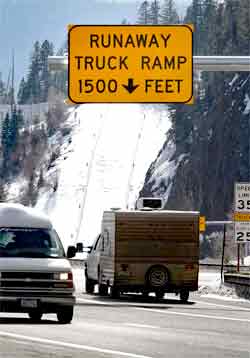
Image provided by Jerry McBride, Durango Herald
Now the fun part: plummeting! Otherwise known as driving down the other side of that steep pass.
Tip #1: Start Slow, Stay Slow
As you approach the top (or crest) of the pass, take your foot off the gas and let the uphill drag bleed off your speed. Use as little gas as necessary to get you to the top. Just as you level out, and before you begin to descend, take your foot off the gas again. If your RV is equipped with engine brakes, engage it now. If not, downshift into a low gear.
Tip #2: Downshift Into a Low Gear
Don’t depend on your automatic transmission to do this. Put the transmission in manual and downshift. Let your engine drag kick in and slow your speed without using the brakes. Your speed should be between 35 MPH and 45 MPH.
Tip #3: Pump Your Brakes When Needed
Don’t ride your brakes. When your speed creeps up to 45 mph, press your brake pedal and lower your speed to 35 mph, then let off the brakes. BRAKE PADS HEAT UP FAST. They can become white hot in seconds. Hot brakes lose their effectiveness and can actually start a fire.
By pumping the brakes, you give the brake pads a chance to cool down. This is the most important tip I can give you for driving an RV in the mountains.
Tip #4: Slow Down Before Sharp Curves
When you see the sign indicating a sharp curve ahead, slow down before you get there. Applying the brakes in a curve can send you into a spin.
How to Recover From A Spin-Out On A Tight Curve
- Slow down before you get there. If you start a spin, DO NOT SLAM ON THE BRAKES.
- Take your foot off the accelerator and keep the steering wheel straight. Avoid over-steering.
- If your vehicle has an electric trailer brake controller, manually and smoothly apply the trailer brakes only.
- When the sway stops, pull over in a safe location to check your trailer hitch connection and tire condition.
Over-Correcting
Another common cause of RV spin-outs is dropping your tire(s) off the right side of the road onto the shoulder. A common reaction is to turn to the left as quickly as possible to get things back on the road. You naturally keep turning left until your tires grip and you climb back onto the roadway. Once back on pavement, your car will go left very fast in the direction you’ve been steering it. This over-correcting may send you flying into oncoming traffic, prompting yet another over-correction, this time to the right.
The correct way to recover is to stay on the shoulder and slow down before making any maneuver. Then pull your vehicle and trailer back on the road safely.
Watch this video of a semi truck driver riding his brakes. The brakes lose their effectiveness and he’s forced to use the Runaway Truck Ramp.
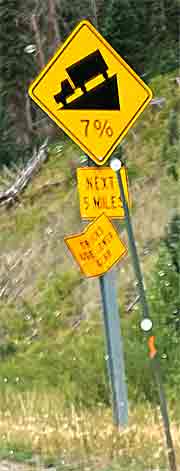
In this 4 minute video by Brad Kinser, we watch an inexperienced trucker rides the brakes until they are useless. He was smart enough to use the Runaway Truck Ramp, saving his own life and possible others.
In this 25 second YouTube® video by Savage Crash Videos, we watch a semi truck’s dashcam coming up the same pass. Just before reaching the hairpin turn, another semi truck (whose driver chose not to use the Runaway Truck Ramp) flies right through a concrete barrier, barreling over the side and falling hundreds of feet to the rocks below.
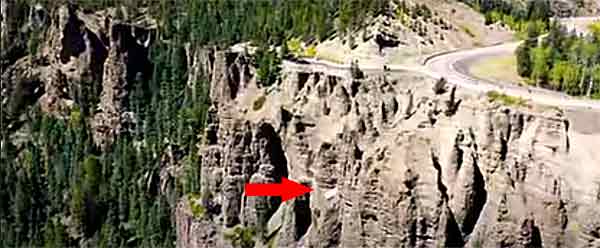
What Makes Wolf Creek Pass So Dangerous
In this photo, a semi trailer hangs precariously off a cliff on Wolf Creek Pass, Colorado. The cab is at the bottom of the cliff; unfortunately, the driver was killed. This is not the only trailer that remains wedged into this mountain cliff.
A large motorhome or a truck towing a destination-size trailer can weigh well over 10,000 lbs. They need to be driven like a semi truck, lest they too fail to negotiate the curve.
This is the fear of inexperienced RVers. But by following these suggestions- checking your brakes, controlling your speed, and paying close attention- everyone can successfully navigate these mountain passes and reach their destinations safely.
Towable RV Brake Systems
There are two types of braking systems used in towable RVs: electric and hydraulic.
Electric Trailer Brakes
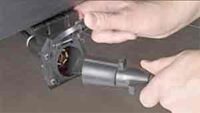
Electric brakes are activated by an electric current through the 7-pin trailer connector. Keep the pins of the connector clean and check your brake lights before every trip. Visit this page of the Tiny Life Consulting website for details on cleaning corroded contacts on these connectors: Melted RV Shore Power Plug How to Avoid Tragedy.
Hydraulic Trailer Brakes
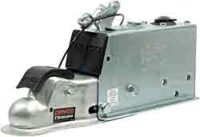 If you have hydraulic trailer brakes, you will know by seeing the hydraulic trailer brake actuator located on the tongue of the trailer. When the tow vehicle slows down, the trailer’s momentum causes the actuator to slide forward, activating the trailer brakes via hydraulic pressure. When the tow vehicle begins to move, the pressure is released and the brakes release.
If you have hydraulic trailer brakes, you will know by seeing the hydraulic trailer brake actuator located on the tongue of the trailer. When the tow vehicle slows down, the trailer’s momentum causes the actuator to slide forward, activating the trailer brakes via hydraulic pressure. When the tow vehicle begins to move, the pressure is released and the brakes release.
There is a brake fluid reservoir in the actuator assembly that should be checked and filled before leaving home, if necessary. This reservoir, or master cylinder, should have a complete fluid change every year or two.
The tiny cable hanging off the actuator is a safety trigger. It needs to be securely fastened to the tow vehicle hitch mount. If the trailer unexpectedly detaches from the tow vehicle it will active the brakes and stop the trailer.
An Important Difference Between Electric and Hydraulic Trailer Brakes
Hydraulic brake actuators remain activated the entire time you are going down a steep hill. This prolonged, continuous braking can cause the trailer brakes to overheat, causing the brakes to lose their effectiveness and possibly damaging the brake system with excessive heat.
Electric brakes will not do this as they activate automatically and proportionally as you press your brake pedal.
Other RV Braking Systems
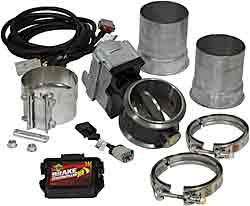
Jake Brakes: Found on many Class A motorhomes, a Jake Brake uses the engine’s compression to slow the vehicle. It’s usually activated with a simple switch on the control panel. If your Class A has a Jake Brake installed, be sure to familiarize yourself with its operation before leaving the driveway. A Jake Brake is an integral part of the engine system and cannot be installed after market.
Exhaust Brakes: Exhaust brakes restrict the engine exhaust, creating a back pressure, forcing the engine to work harder against this resistance which slows the vehicle down. These can be added after market.
Specific Mountain Road Hazards
Keep your eyes open for these common road hazards in the mountains.
Animals
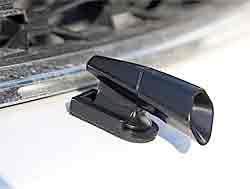 Animals like deer and elk are on the move at dawn and dusk. Dodge them if you can do so safely. We have put deer alerts on every car we’ve owned so they hear us coming. We see them pick up their heads and notice us when we drive by. They are not expensive.
Animals like deer and elk are on the move at dawn and dusk. Dodge them if you can do so safely. We have put deer alerts on every car we’ve owned so they hear us coming. We see them pick up their heads and notice us when we drive by. They are not expensive.
Deer warning whistles help keep these pesky critters from becoming roadkill. The ultrasonic whistle is inaudible to humans or pets inside your car, as it is way out of the normal hearing range of people. They are easy to remove from the base when your need to go through a car wash, replace, adjust, etc.
Rocks and Mud
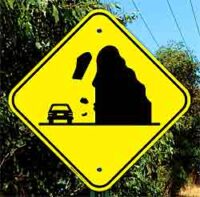 Falling rocks. When you see the sign, believe it. Wherever roads cut through mountains, there will be exposed rocks. Heavy rain, as well as freezing and thawing, can loosen rocks, sending them crashing onto the road. The Colorado Department of Transportation does everything it can to mitigate the risk, but often that is not enough.
Falling rocks. When you see the sign, believe it. Wherever roads cut through mountains, there will be exposed rocks. Heavy rain, as well as freezing and thawing, can loosen rocks, sending them crashing onto the road. The Colorado Department of Transportation does everything it can to mitigate the risk, but often that is not enough.
Mudslides, especially near wildfire burn scars, are also common. Keep an eye on the weather. “Know before you go.”
Visit CoTrip.org check your route for hazards and construction delays.
Use a good app like RV Life Trip Wizard to plan the best route.
High Crosswinds
Your RV, whether towed or driven, is susceptible to crosswinds. A gust of wind can easily cause your rig to change lanes or even tip over.
The RV Life Trip Wizard app has an RV-specific planning tool that includes a wind speed feature under its “Weather Layers” in map settings. This allows you to proactively check wind conditions for your planned route, helping you avoid high wind areas or regions.
The Scenery Is Awesome
Yes, we know you want to gawk out the window, but you must keep your attention riveted on the road. Pull off at provided areas to take in the view and snap a few pictures. If you can’t keep your eyes on the road, let your spouse drive.
Mountain Passes To Avoid
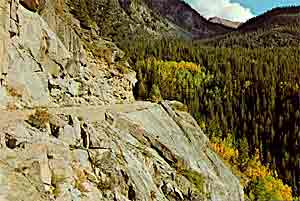
There are a couple of Colorado passes I’d never do again in an RV.
Independence Pass
Independence Pass, or Colorado Highway 82 between Aspen and Leadville, should be avoided by anyone in a motorhome or towing a camper trailer. Not because it’s so steep, though it is, and not because of the hairpin turns (there are many), but because of the narrow road on the Aspen side. There is a spot that is one lane wide, on a blind curve, where the cliffs above hang out over the road so low a camper can’t get underneath. There are no guardrails in this area either.
Vehicles over 35′ in length are prohibited. You’ll probably be OK in a Class B, or a pickup truck with a camper on the back.
Cottonwood Pass
I-70 through Glenwood Canyon closes frequently. The only way around is driving all the way up to Craig, then back down to Rifle. Google Maps has mistakenly sent travelers over Cottonwood Pass instead. This unimproved mountain pass between Eagle and the Frying Pan Rd. looks good on paper, but don’t do it. You might make it if you have an AWD truck with a heavy duty trailer like the AUSRV.
Leave a comment below if there are other passes you feel should be avoided in an RV.
Final Thoughts
You can do this. Follow the tips on this page and you’ll be fine.
More pages of the Tiny Life Consulting You’ll be interested in:
Melted RV Shore Power Plug How to Avoid Tragedy
How to Repair and Remodel an RV
How to Drain and Maintain Your RV Holding Tanks
Best Air Conditioners for RVs and Tiny Houses
Running RV Appliances Like Air Conditioners Off-Grid
Roamly RV Insurance Compared to Progressive


